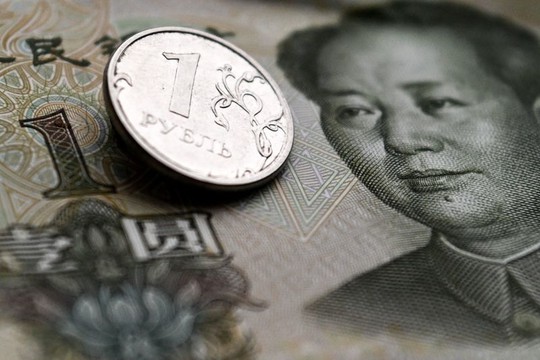Photo: AFP/Getty Images
The conventional wisdom on financial markets holds that as long as China declines to make the yuan fully convertible, it will not be able to rival the dollar or euro as a global currency, notes Bloomberg.
China’s influence over the Russian market just got a lot more intense. For the first time in the history of the Moscow Exchange, the yuan overtook the US dollar as the most traded currency last month with a market share close to 40% of trading volume.
A closer look at the regional dimension of the yuan’s internationalization, however, provides a more complex picture. As a result of war in Ukraine and Western sanctions against Russia, the yuan has suddenly found itself on the way to becoming the dominant regional currency in northern Eurasia.
The de-dollarization of the Russian economy ordered by the Kremlin after the 2014 did not go smoothly… But special military operation in Ukraine and the ensuing sanctions have changed everything.
Russia’s dependency on the yuan is growing rapidly across the board. The share of Russian exports settled in renminbi grew from 0.4% to 14% in the first nine months of 2022, according to Bank of Russia data. Yuan deposits have become available in all major banks, and so the Russian households’ yuan holdings jumped from zero to $6 billion in the same period: that’s 11% of the foreign currency they hold.
The Moscow Stock Exchange also shows demand for yuan going through the roof, with trading in renminbi increasing to 33% from 3% before the war. The number of days when trading in yuan on the exchange exceeds the volume of trade in dollars and euros is constantly growing.
These groundbreaking changes can be explained not just by restricted access to the dollar and euro in Russia as the result of sanctions, but also by the tectonic shifts in the geography of Russian trade. Moscow’s imports from the West have crashed because of sanctions, and exports to the West are increasingly affected, too. Against this backdrop, Moscow was forced to shift the majority of its trade to China, which in 2022 accounted for 40% of Russian imports and 30% of exports…
Some other countries in the Eurasian landmass with growing trade dependency on China, like the Central Asian republics or Pakistan, may gradually follow suit. Other countries like Saudi Arabia are watching Russia’s experience closely, and though they predominantly still rely on the dollar, they will cautiously increase the share of the yuan, reflecting not only a desire to hedge against the US weaponization of the global financial system, but also the growing ability of China to provide its trading partners with most goods they need, including advanced technology.
Geopolitics will not, of course, lead to the global dethronement of the dollar any time soon. But it might lead to the gradual formation of a yuan-centered regional financial architecture in China’s neighborhood — and the further ‘balkanization’ of the global financial system. Beyond equipping China with another tool of geoeconomic power, this trend will further fragment the global economy into Beijing-led and Washington-led blocs.
The costs of putting the squeeze on Russia may be higher than Washington seems to realize.
read more in our Telegram-channel https://t.me/The_International_Affairs

 11:59 20.03.2023 •
11:59 20.03.2023 •























